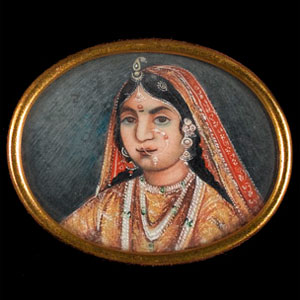
Rani of Jhansi. Miniature on paper by an unknown Indian artist, c. 1857. Image courtesy National Army Museum.
The Rani was remarkable for her bravery, cleverness and perseverance; her generosity to her subordinates was unbounded. These qualities, combined with her rank, rendered her the most dangerous of the rebel leaders.
-Sir Hugh Rose
Rani Laksmi Bai became one of the leading figures in the 1857 Indian Rebellion against the rule of the British East India Company. She was brought up at the Bithur Court of the Martha Peshwa where her father was an official and therefore enjoyed more independence than most girls of the time. Whilst at court Rani was well-educated. She also studied horsemanship, archery, and became expertly skilled with a sword.
In 1842, when only seven years old, Rani married the Rajah of Jhansi who would die eleven years later, leaving no direct male heir. Taking advantage of this situation, the British East India Company seized the kingdom and expanded their already growing empire. It was not long before the Indian Rebellion made its way from Meerut with many supporting the cause in the hope that the old Jhansi state would be restored. Rani was reluctantly forced to take action against the British. She raised a volunteer army of 14,000 men and women, leading them to victory, and then instantly set about strengthening defences. The British struck back on the 24th of May, 1858 with a force led by Major-General Sir Hugh Rose, and besieged Jhansi. Rani stood firm and fought to defend the city, but she was defeated. Jhansi was stormed and looted by the British with many of the rebels hanged for their resistance, including Rani’s father. Rani herself managed to escape with her adopted son and bodyguard. She met up with other rebel forces, including those of Tatya Tope, and advanced to Gwalior where they hoped to defeat the British. It was at this battle that the brave Rani attempted to stop her soldiers from fleeing by charging with a sword in each hand at the enemy with the reins for the horse held between her teeth. As she was charging, however, she was shot. Knowing death was near she ordered her supporters to burn her body.
Rani was an incredible woman who possessed the intelligence to lead armies into battle and rule her kingdom effectively, despite being only eighteen when her husband died. She was a brave woman who earned the respect of her enemies and conquered the hearts of the rebels fighting. In later times she was hailed as the ‘Indian Joan of Arc’ and would be recognised by Indian nationalists as the forerunner to Indian independence. Rani has become a national heroine in India, and in 1943 the Indian National Army paid tribute to her by establishing an all-female regiment in her name. What better way to remember such an inspirational woman who died fighting for independence?
-Claire Amundson
Junior Girl
Girl Museum Inc.
